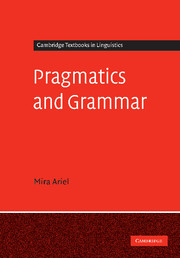Book contents
- Frontmatter
- Contents
- List of tables
- Preface
- Acknowledgments
- How to use this book
- Transcription conventions
- 1 Introduction: Grammar, pragmatics, and what's between them
- PART I Drawing the grammar/pragmatics divide
- 2 Distinguishing the grammatical and the extragrammatical: referential expressions
- 3 Distinguishing codes, explicated, implicated, and truth-compatible inferences
- PART II Crossing the extralinguistic/linguistic divide
- Part III Bringing grammar and pragmatics back together
- References
- Author index
- Subject index
3 - Distinguishing codes, explicated, implicated, and truth-compatible inferences
referential expressions
Published online by Cambridge University Press: 05 September 2012
- Frontmatter
- Contents
- List of tables
- Preface
- Acknowledgments
- How to use this book
- Transcription conventions
- 1 Introduction: Grammar, pragmatics, and what's between them
- PART I Drawing the grammar/pragmatics divide
- 2 Distinguishing the grammatical and the extragrammatical: referential expressions
- 3 Distinguishing codes, explicated, implicated, and truth-compatible inferences
- PART II Crossing the extralinguistic/linguistic divide
- Part III Bringing grammar and pragmatics back together
- References
- Author index
- Subject index
Summary
We have already introduced Grice's “Modified Occam's Razor Principle” in section 1.3: 2: “Senses are not to be multiplied beyond necessity” (Grice, 1989: 47). By the senses not to be multiplied, Grice meant specifically semantic, rather than pragmatic meanings. The received view is that if a linguistic form seems to have more than one interpretation, we should try to avoid positing semantic ambiguity. If at all possible, we should assign a single semantic meaning to the form, and derive the other interpretation(s) pragmatically. All things being equal, then, whenever possible, additional attested meanings should be viewed as pragmatic rather than semantic. This was the position we adopted in section 2.2 when we tried (and failed) to analyze the accessibility-associated distributional patterns of referring expressions as pragmatically inferred rather than grammatically stipulated. Prime examples offered in the literature include and, or, and if, for each of which, following especially Horn (1972), Griceans propose one semantic meaning (their logical operator counterpart), despite the variety of contextual interpretations they manifest in discourse.
Moreover, even if linguistic forms seem to have one invariable meaning (e.g. but, some, six), Griceans still try to minimize their semantics, by analyzing some aspects of their meanings (‘contrast’ for but, the upper bound for some and for six) as pragmatic. Only part of their meaning is assigned to their semantics (‘and’ for but, ‘at least one’ for some, ‘at least six’ for six).
- Type
- Chapter
- Information
- Pragmatics and Grammar , pp. 68 - 110Publisher: Cambridge University PressPrint publication year: 2008



